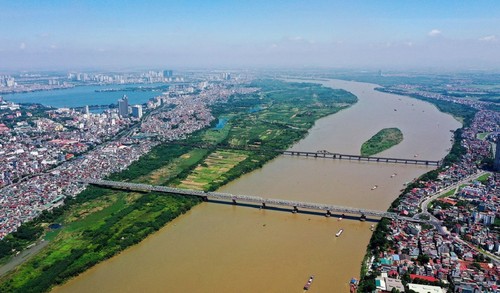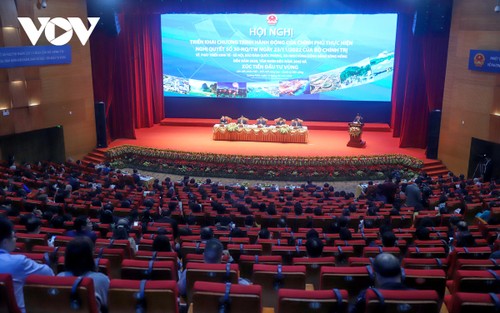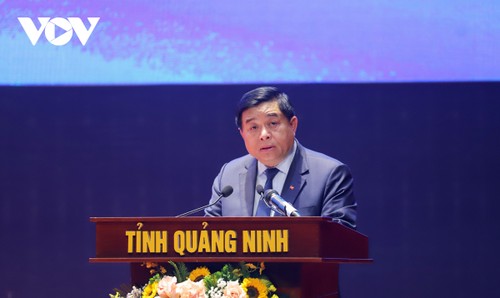 The Red River Delta holds an important position in national economic development (Photo: VNA) The Red River Delta holds an important position in national economic development (Photo: VNA) |
The Red River Delta covers the downstream area of the Red River and Thai Binh River in northern Vietnam. The region encompasses 11 provinces and cities: Hanoi, Hung Yen, Hai Duong, Hai Phong, Bac Ninh, Vinh Phuc, Ha Nam, Thai Binh, Nam Dinh, Ninh Binh and Quang Ninh. Spanning nearly 15,000 square kilometers, it’s the second largest delta in Vietnam, with 21.6 million people or 22% of Vietnam’s population.
The Red River Delta region connects Vietnam’s northwestern and north-central regions and leads to other regions further south. With Noi Bai airport, Van Don airport, and Hai Phong port serving as gateways to the world, the Red River Delta holds strategic importance in terms of politics, economy, culture, society, environment, national defense, security, and maritime sovereignty and is a bridge to markets around the world.
 A conference on the implementation of Politburo Resolution 30 on Red River Delta's development (Photo: Truong Giang/VOV) A conference on the implementation of Politburo Resolution 30 on Red River Delta's development (Photo: Truong Giang/VOV) |
Red River Delta should be developed into a major economic driver
To realize Politburo Resolution 30 on the Red River Delta’s development orientations, the Government has set specific targets for 2030 and outlined 20 infrastructure investment projects.
The region hopes to achieve an average annual growth rate of 9% in the 2021-2030 period, a GRDP per capita of 11,600 USD/year, average productivity growth of over 7%, and a poverty reduction rate of 1.5%/year. By 2030, the Red River Delta will become a region with rapid and sustainable development, an effective economic structure, national cultural identity, modern industry and services, high-tech, and an organic, green, circular agriculture with high economic value.
It will become a national center of education and training of high-quality human resources, take the lead in science-technology development, innovation, digital economy, and digital society and have a coordinated, modern socio-economic infrastructure and smart, highly connected urban areas.
Minister of Planning and Investment Nguyen Chi Dung said: "We need to continue to promote the development of sub-regions, in which the northern key economic region is the political-economic, cultural, educational, scientific and technological center of the whole country and the driving force for the development of the Red River Delta."
"It is necessary to mobilize maximum resources for regional development, focus investment in infrastructure development, and expand the network of expressways, highways, ring roads, inter-regional coastal roads, seaports, airports, and railways in order to ensure connection between regions and sub-regions," added Mr. Dung.
 Minister of Planning and Investment Nguyen Chi Dung speaks at the conference (Photo: Truong Giang/VOV) Minister of Planning and Investment Nguyen Chi Dung speaks at the conference (Photo: Truong Giang/VOV) |
Consensus at all levels
At the conference, leaders of ministries and sectors discussed solutions to implement the Politburo Resolution and the Government’s action plan on the development of the Red River Delta. They stressed the need to focus on upgrading the transportation network to strengthen links between the region and the world and to make it a leading science-technology and innovation center in the country.
More efforts will be made to develop the labor market, link labor supply and demand to meet the needs of regional development, develop modern, high-tech industries, and engage more in the global production and supply chains.
Minister of Labor, Invalids and Social Affairs Dao Ngoc Dung elaborated on solutions to develop the labor market.
"It’s necessary to take a short cut in human resource transformation, pay attention to high-quality human resources, focus on higher education and vocational education, and modernize the development of employment services in the Red River Delta. We also need to strengthen linkages with labor markets in other regions and developed countries," said Mr. Dung.
Leaders of Hanoi, Quang Ninh, Hai Phong, and Ha Nam introduced local development plans based on the region’s plan. Hanoi intends to become a smart, modern city and a driving force for regional and national development. Hai Phong will develop its marine economy toward green growth and intends to become an urban-service-tourism center connecting with the region and the world. Ha Nam will attract investment in AI, automation, biotechnology and new industrial products. At the conference, leaders of foreign businesses and organizations recommended solutions for the development of the Red River Delta.
It was the 6th conference that the Government has held to implement the Politburo resolutions on regional development throughout the country. According to Party leader Nguyen Phu Trong, reaching a consensus at all levels on the development orientations of the Red River Delta will bring into full play the region’s potential and outstanding advantages to ensure its rapid, sustainable development.